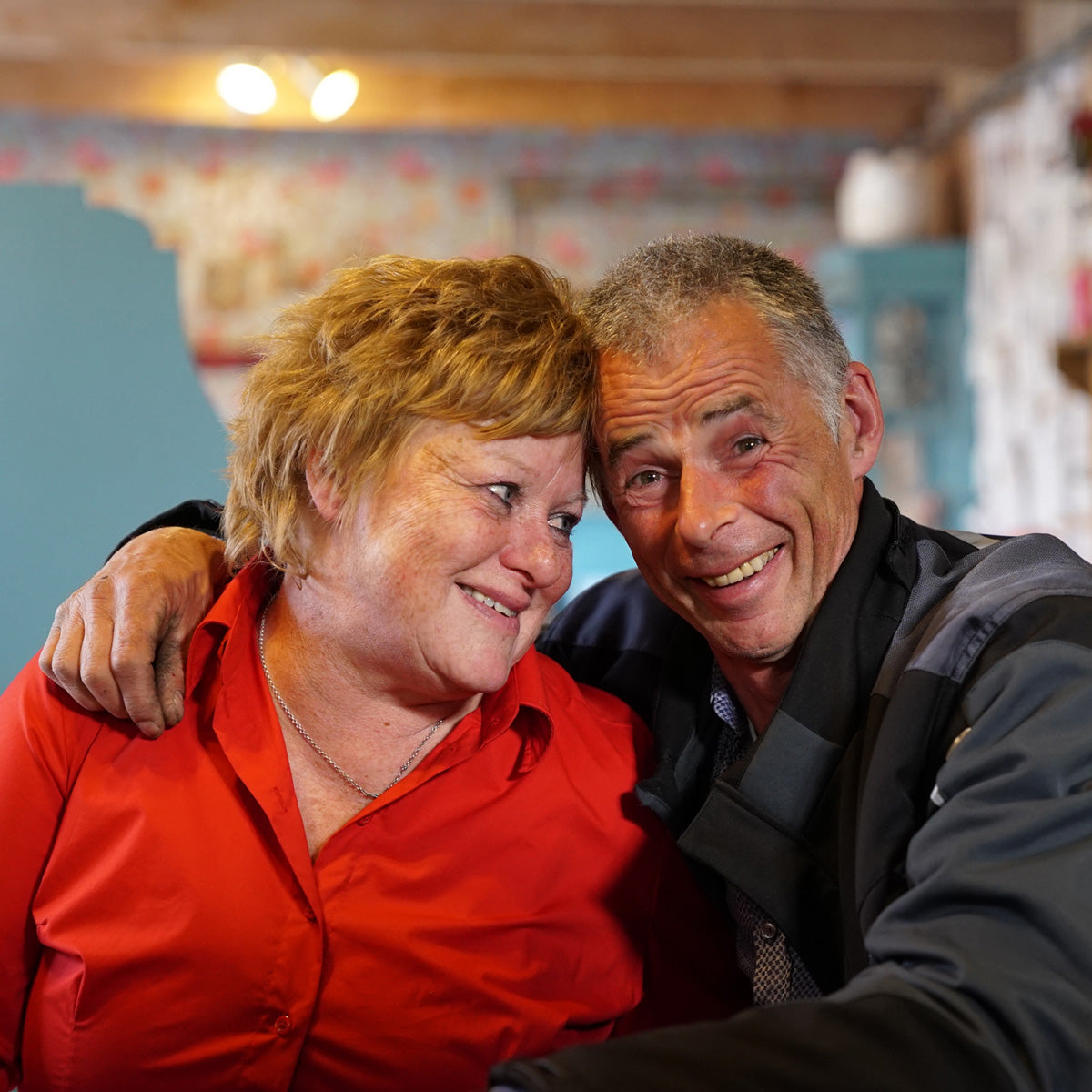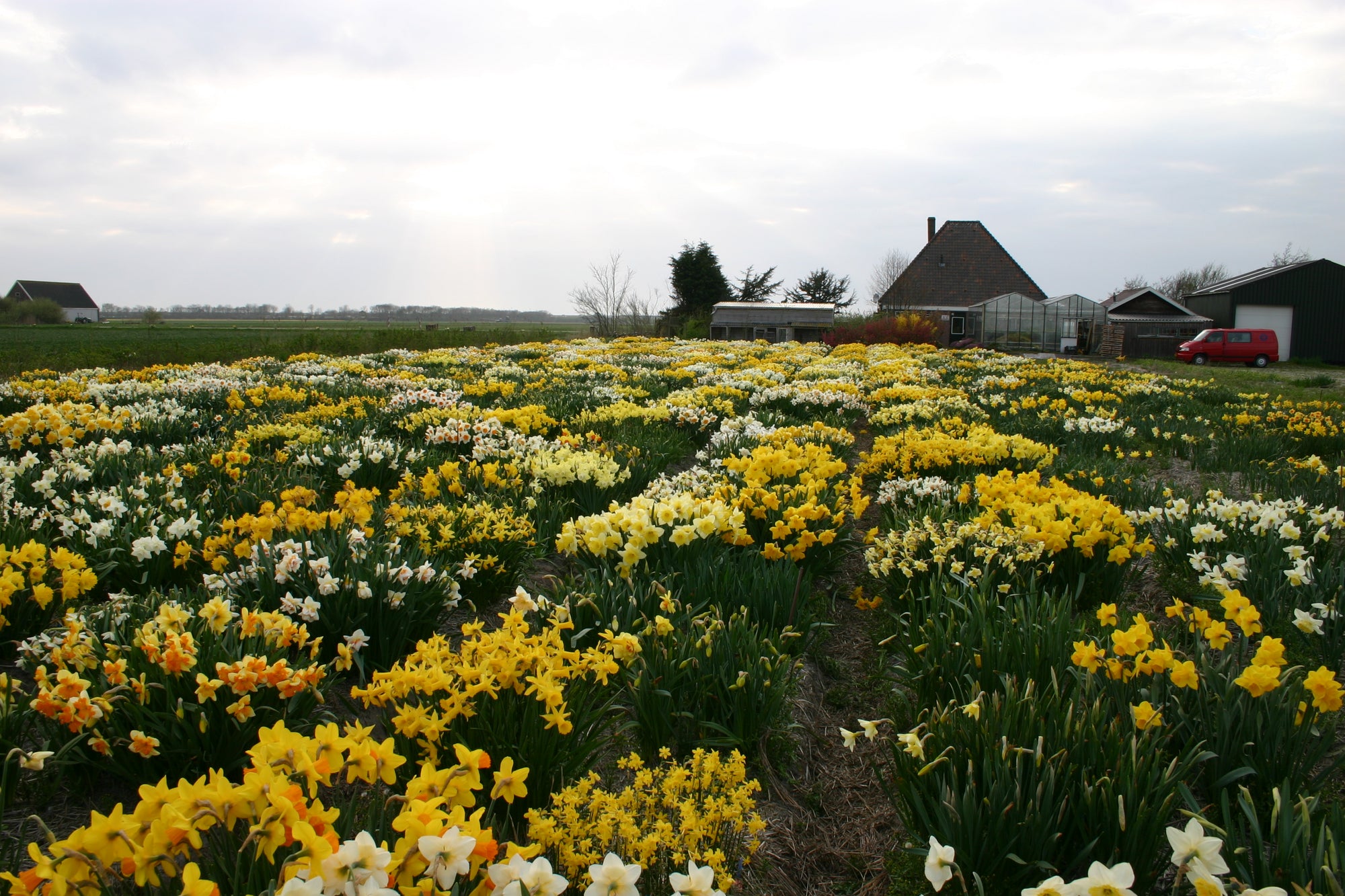In the split
Yes, you know what it is: Sometimes I have to choose and I can't choose at all because the choice is between a nice job and an even nicer job: Writing a news blog or caring for daffodil flowers in my greenhouse.

You may have wondered how I can tell so much sense and nonsense about flower bulbs, but that is because I have been around them almost all my life, all year round, and that is because of the greenhouse behind our house. The Amaryllis are already blooming there in December.

After this, when the last Amaryllis are still blooming, the first Daffodils start to flower. I plant not dozens, but hundreds of varieties of Daffodils in pots every year to see them in the greenhouse. A pot of almost all the varieties in our nursery are planted every year. Not just because I like it. No, mainly to take photos that I can use in the Fluwel web shop, because without photos you won't sell much. Of course I could also try to take the photos in the spring when the Daffodils are blooming in the field, but we live too close to the North Sea coast for that. The chance of a flower-destroying storm in the open field is simply too large here. Many will now think 'is it really that windy over there?’ Well, come and live along the coast in the north of North Holland for a few years. Wind that comes directly from the sea is truly something different.

Three sturdy pines in the Pettemer forest close to Sint Maartenszee.
I recently read it put quite compellingly on a board in Den Helder: You don't know what wind is if you haven't lived in Den Helder. A truth like a cow, as we like to say in Dutch.
It can happen that you want to take a nice photo of a new Daffodil three years in a row and it gets blown to pieces every time it will just start to come up. So, plant it in a pot in the greenhouse: no rain, no wind, nice and warm and, if necessary, take the time to write a piece of text about it. While the Daffodils are still blooming in the greenhouse, things continue outside. Suddenly the Snowdrops are in full bloom again and as soon as they have finished blooming, the first Daffodils come back to life outside, followed by the Tulips, the Alliums, the Peonies (yes, this year we will be offering Peonies for the first time in the Fluwel web shop), the Lilies, Begonias and don't forget the Dahlias all summer long. In between, of course, we also have to look at all kinds of lesser-known bulbous plants such as Zantedeschia, Crocosmia, Acidantera, Hyacinth, Muscari, Eucomis, Anemone and whatever else comes across. Before you know it, you will be regularly walking among the flower bulbs from December until well into October and if you have been doing that for over 40 years, like me, you will by the end know quite a bit about flower bulbs.

Gladiolus callianthus Murielae
But now I'm really in a split. The last Amaryllis are still blooming in my greenhouse and due to the once again extremely mild weather, the Snowdrops are already dropping in full swing and my greenhouse is already filled with blooming Daffodils. But now that I have to choose between the pleasant and the pleasant, I might as well combine it. Yesterday I was writing texts in the greenhouse about a few new Daffodils for the Fluwel web shop and I will simply put them in the newsletter.

Cremello
As a parent, you are of course never allowed to say it, but luckily we as Daffodil breeders have nothing to do with that, but Cremello is really one of my favorite Daffodils. Wonderfully large flowers with a beautiful shape as well, but especially that phenomenal color. Simply unique, formidable, sensational. If you ask me what color Cremello is, the answer unfortunately (unfortunately for a Daffodil, I mean: people seem to want them to be anything but yellow sometimes, though I have no clue why) has to be yellow, because after all yellow is yellow. But I have been thinking for two glasses of wine long how to best describe this particularly yellow-colored Cremello. Sweet yellow, mild yellow, weak yellow, no, that's wrong, she's too cool for that. Sultry yellow, tender yellow, juicy yellow, calm yellow, benign yellow, velvety yellow. Or perhaps it would be better to have friendly yellow or gentle yellow or something like tender yellow. You can also call it fluffy yellow, maybe even erotic or sexy yellow. No, I'm not that in love with the Cremello. Whatever yellow it is, one thing is certain; she is beautiful and that's what she is and the color…sultry yellow, that's what it turned out to be. Plant it and enjoy its sultry yellow and if you pick a few for the vase in the living room, a different shade of sultry yellow will show up.

Narcissus Englander
Another story I wrote this week is about the Daffodil Englander: a curious little rascal who is one of the first to come and peek in the garden with her long nose. The Snowdrops have not even finished dripping when this Englander cheerfully announces the arrival of the Daffodils. At first glance it appears to be a slender and tender looking Daffodil, but appearances are deceiving. It is tough, blooms for a very long time and comes back for years. A little force of nature. These Daffodils are already available in the Fluwel web shop under the “Fluwel Special Narcissus”.

I was asked a few times last week why the Daffodils from our nursery were already available in the web shop while the other Daffodils and spring blooming varieties were not yet available.
The majority of the ‘Fluwel Special Narcissus' collection was sold in the past by Frankie Charlton, who specialized in Daffodils for the English flower shows under the names Choice Bulbs and Miniature Bulbs.

Joyce & Frankie at the RHS Daffodil Show at Wisley Gardens
His buyers were mainly people who also exhibit Daffodils at Daffodil shows. Frankie, together with his wife Joyce, showed his flowers at these shows, which start in the south of England at the end of February, and always made sure that he could immediately offer them to enthusiasts who showed an interest in his varieties. Frankie still promotes Daffodils and now that we take care of the sales and shipping, we have supplemented his entire collection with all our own Daffodils and put them online so that Frankie can offer them to enthusiasts at the Daffodil Shows.

Daffodil Beautiful Dream
Of course the question arose as to why some are so expensive. Well, that's really just supply and demand. In this case, that means high demand and almost no bulbs. Take a Daffodil like The Godfather. Everyone who sees her wants to have her, flowers almost larger than those of an Amaryllis. If I want to maintain my stock and let it increase a bit so I can actually offer more every year, I really can't sell more than about 20 bulbs. What would you do if you were in my shoes? This is also the case with Daffodils, which win many prizes at The Daffodil Shows in England and America. High prices mean high demand and only a few bulbs available. These varieties are just that small in number, and there are one, or two, sometimes a handful of people in the world growing them, the varieties we’re talking about don’t exist outside of these few growers.
I think I should stop now, imagine that I was actually planning not to write a news blog this week at all... I just love to write.
Kind regards,
Carlos van der Veek
One more, the text to Beautiful Dream that I wrote this week. It was not without reason that I looked up that beautiful photo: Beautiful Dream, the dream that every breeder dreams; to breed a beautiful large, bright white and joyful Daffodil. America-based breeder Elise Havens, also known as Grant E. Mitsch, has succeeded. What a beauty, what a dream of a Daffodil. Every spring the Beautiful Dream, with its huge sparkling flowers, is an eye-catcher at our nursery. Now I have the beautiful dream that she will grow well for us so we can offer them to hundreds of Daffodil lovers in the future. So far so good, she has never let us down. Here are the first bulbs.

 Deutsch
Deutsch English
English Nederlands
Nederlands
